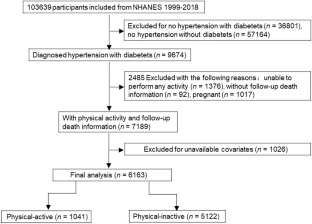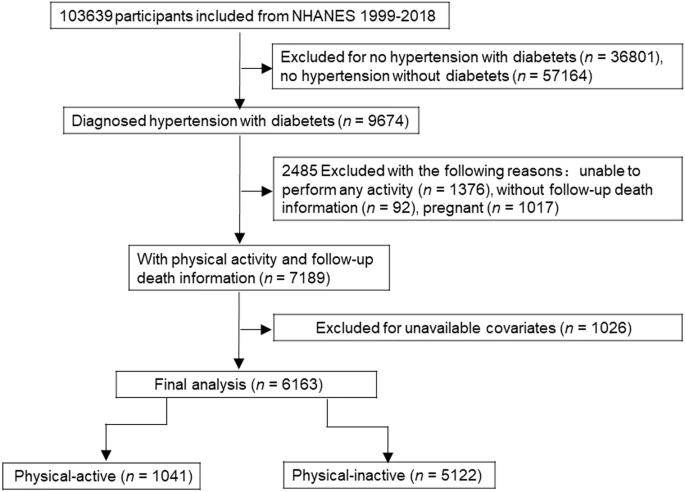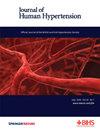体育锻炼可降低高血压糖尿病患者的血压和死亡率:1999-2018 年美国国家健康与营养调查(NHANES)数据。
IF 2.7
4区 医学
Q2 PERIPHERAL VASCULAR DISEASE
引用次数: 0
摘要
在以往与体育锻炼有关的研究中,研究人员往往只关注有限的几项活动,很少关注与死亡率有关的结果,也没有充分关注糖尿病合并高血压患者的结果。研究人员对 1999-2018 年期间的全国健康与营养调查进行了评估,以确定同时患有糖尿病和高血压的人群。这些人被分为身体活跃和不活跃两类。组间比较采用了适当的统计检验。本研究共评估了 6,163 名患者的数据,他们的平均年龄为(63.18 ± 12.80)岁。50.30%的参与者为男性,39.86%为非西班牙裔白人,57.17%体重指数正常,89.20%有保险。在总体人群中,体育锻炼与收缩压呈明显负相关(p = 0.01),而在接受降压药物治疗的人群中,体育锻炼与收缩压呈明显负相关(p = 0.0035)。即使在对年龄、性别和种族进行调整后,这种负相关关系仍然保持不变(p = 0.03)。在所有参与者中,体育锻炼与舒张压呈正相关(p = 0.002),在对接受降压药物治疗的参与者进行专门评估时,体育锻炼与舒张压呈正相关(p = 0.02)。在被归类为缺乏运动的人群中,全因死亡率和高血压死亡率风险水平明显更高(p = 0.002)。本文章由计算机程序翻译,如有差异,请以英文原文为准。


Physical activity lower blood pressure and mortality in hypertensive patients with diabetes: data from National Health and Nutrition Examination Survey (NHANES) 1999–2018
In prior research related to physical activity, researchers have often centered their focus on only a limited number of activities, with little regard for mortality-related outcomes and insufficient focus on outcomes among diabetes patients with hypertension. The National Health and Nutrition Examination Survey was evaluated from 1999-2018 to identify individual with both diabetes and hypertension. These individuals were classified as being physically active or inactive. Comparisons among groups were performed with appropriate statistical tests. In total, this study evaluated data from 6,163 patients with a mean age of 63.18 ± 12.80 years. A total of 50.30% of the participants were male, with 39.86% being non-Hispanic white, 57.17% with a normal body mass index, and 89.20% were insured. Physical activity was significantly negatively correlated with systolic blood pressure in the overall population (p = 0.01) and when specifically focusing on individuals undergoing antihypertensive drug treatment (p = 0.0035). This negative relationship remained intact even following adjustment for age, sex, and ethnicity (p = 0.03). Physical activity was positively correlated with diastolic blood pressure in the overall population of participants (p = 0.002) and when specifically evaluating participants undergoing antihypertensive drug treatment (p = 0.02). All-cause and hypertensive mortality risk levels were significantly higher among individuals classified as being physically inactive (p < 0.0001), and this relationship remained true even with adjustment for age, sex, and ethnicity (p < 0.0001). In conclusion, physical activity is capable of lowering systolic blood pressure and decreasing the incidence of mortality among diabetes patients with hypertension.
求助全文
通过发布文献求助,成功后即可免费获取论文全文。
去求助
来源期刊

Journal of Human Hypertension
医学-外周血管病
CiteScore
5.20
自引率
3.70%
发文量
126
审稿时长
6-12 weeks
期刊介绍:
Journal of Human Hypertension is published monthly and is of interest to health care professionals who deal with hypertension (specialists, internists, primary care physicians) and public health workers. We believe that our patients benefit from robust scientific data that are based on well conducted clinical trials. We also believe that basic sciences are the foundations on which we build our knowledge of clinical conditions and their management. Towards this end, although we are primarily a clinical based journal, we also welcome suitable basic sciences studies that promote our understanding of human hypertension.
The journal aims to perform the dual role of increasing knowledge in the field of high blood pressure as well as improving the standard of care of patients. The editors will consider for publication all suitable papers dealing directly or indirectly with clinical aspects of hypertension, including but not limited to epidemiology, pathophysiology, therapeutics and basic sciences involving human subjects or tissues. We also consider papers from all specialties such as ophthalmology, cardiology, nephrology, obstetrics and stroke medicine that deal with the various aspects of hypertension and its complications.
 求助内容:
求助内容: 应助结果提醒方式:
应助结果提醒方式:


